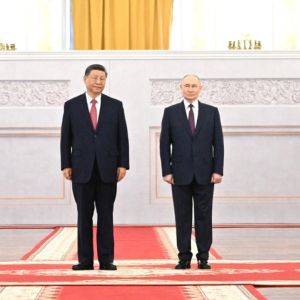
Russian President Vladimir Putin and Chinese President Xi Jinping launched bilateral meetings in Moscow this week, at a time when China is holding talks with the West to cool down trade tensions. Both leaders seemingly want to improve the productivity of their alliance and reduce their reliance on the United States and its allies. The four-day summit, which began Wednesday, coincides with Russia’s 80th anniversary commemorations marking the end of World War II. Per a Thursday Bloomberg report , leaders from more than 20 countries, including Brazilian President Luiz Inacio Lula da Silva, are expected to attend the event. Russia and China to discuss trade future At the start of Thursday’s talks, Putin described the China-Russia relationship as a “fully fledged partnership” rooted in mutual strategic interests. “We are developing our ties in the interests of both our peoples and not aimed against anyone,” he remarked. The meeting marks the first in-person engagement between the two leaders since US President Donald Trump imposed tariffs on foreign goods, which strained Washington’s ties with its traditional allies, particularly China. Western sanctions have made China and Russia’s economic relationship stronger, especially since Russia’s invasion of Ukraine in 2022. In 2024, bilateral trade between the two nations reached a record $245 billion, more than double the level in 2020. Russian exports to China are dominated by fossil fuels and raw materials, while Chinese exports include vehicles, electronics, and other manufactured goods. A joint dashboard by MERICS, OSW, and UI tracking China-Russia economic trends shows that Chinese exports of civil-military dual-use goods, like advanced machine tools and chip-making equipment, have risen sharply since 2022. Chinese imports of Russian crude oil soared to $62.26 billion in 2024, up 54% from 2021, the year before Western sanctions on Russian energy exports took effect. Russian oil exports to China also increased to over 108 million tonnes in 2024, a 30% uptick in 2 years. Russian coal exports to China also accelerated following sanctions, peaking in 2023. The momentum slowed in 2024 because China expanded its domestic coal production and diversified imports. Meanwhile, Russian LNG exports to China have more than tripled since 2019, reaching 8.3 million tonnes in 2024. Although the pandemic briefly interrupted trade in 2021, LNG volumes quickly rebounded in subsequent years. On the Pipeline gas front, the Power of Siberia-1 pipeline, launched in 2019, is set to reach its full annual capacity of 38 billion cubic meters by 2025. This infrastructure project has helped Moscow offset the collapse of gas exports to the European Union. Diplomatic ties to survive without America Beyond trade, China has provided years of diplomatic support to Russia since the outbreak of the war in Ukraine. Just weeks before the 2022 invasion, the two countries declared a “no limits” friendship to deepen their cooperation in the face of increasing Western influence on the global economy. This week’s meetings in Moscow will also address joint coordination in global platforms such as the BRICS collective and the Group of 20, as confirmed by Ushakov. Patricia Kim, an economist from the Brookings Institution told the Washington Post that Xi’s trip to Moscow gives China a chance to reaffirm its “close partnership with Putin” and to “remind the world” that Beijing and Moscow have “solid ties.” Close to 40% of Russia’s international trade is now settled in Chinese yuan, an increase from a meager 2% in early 2022. President Trump will not be happy about the growing ties between Russia and China, as he has stated in multiple public appearances that he views their partnership as a “ threat to America .” Speaking again in March during a Fox News interview, he warned US trade allies that they “don’t want Russia and China to get together.” Cryptopolitan Academy: Coming Soon - A New Way to Earn Passive Income with DeFi in 2025. Learn More
